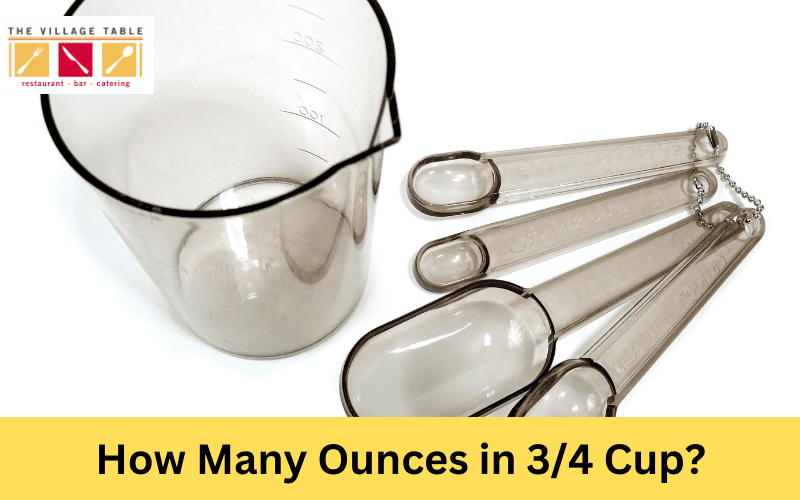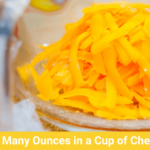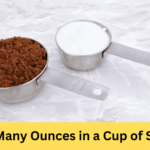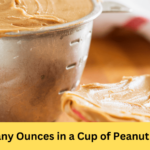If you love cooking or baking, you’ve probably come across recipes that measure ingredients in cups and ounces. Understanding the conversion between these measurements is essential for achieving the perfect results in your culinary endeavors. In this article, we will dive deep into the question: How many ounces in 3/4 cup and provide you with a comprehensive guide to help you navigate the world of measurements in the kitchen. So grab your apron and let’s get started!
How Many Ounces in 3/4 Cup?
When it comes to converting between cups and ounces, it’s important to know that the answer depends on the ingredient you’re measuring. Different ingredients have varying densities, resulting in different conversion ratios.
For liquid ingredients, such as water or milk, 1 cup is equivalent to 8 fluid ounces (fl oz). Therefore, 3/4 cup is equal to 6 fluid ounces.
For dry ingredients, such as flour or sugar, 1 cup is equivalent to 8 ounces (oz). Thus, 3/4 cup of dry ingredients weighs approximately 6 ounces.
Converting Cups to Ounces
Converting from cups to ounces is a straightforward process once you understand the basic conversion ratios. To convert cups to ounces, you can use the following conversion factors:
- For liquid ingredients: 1 cup = 8 fluid ounces
- For dry ingredients: 1 cup = 8 ounces
To convert any given measurement in cups to ounces, multiply the number of cups by the appropriate conversion factor. For example, to convert 2 cups to ounces, you would multiply 2 by 8, resulting in 16 ounces.
Converting Ounces to Cups
On the other hand, if you have a measurement in ounces and want to convert it to cups, you can use the inverse of the conversion factors mentioned above. To convert ounces to cups, apply the following conversion factors:
- For liquid ingredients: 1 fluid ounce = 1/8 cup
- For dry ingredients: 1 ounce = 1/8 cup
To convert a given measurement in ounces to cups, divide the number of ounces by the appropriate conversion factor. For instance, to convert 12 ounces to cups, you would divide 12 by 8, resulting in 1.5 cups.
FAQs
How many tablespoons are there in 3/4 cup?
To determine the number of tablespoons in 3/4 cup, we can use the conversion ratio that states 1 cup is equal to 16 tablespoons. Therefore, 3/4 cup is equivalent to 12 tablespoons.
What is the conversion factor for cups to milliliters?
The conversion factor for converting cups to milliliters is 1 cup = 237 milliliters (ml). This conversion is useful when following recipes from different regions that use metric measurements.
How many fluid ounces are there in a cup?
As mentioned earlier, there are 8 fluid ounces in a cup. This conversion is commonly used in the United States and other countries that follow the US customary system.
How can I convert grams to ounces?
To convert grams to ounces, you can use the conversion factor that states 1 ounce is equal to approximately 28.35 grams. Divide the number of grams by this conversion factor to obtain the equivalent weight in ounces.
What is the difference between dry ounces and fluid ounces?
The main difference between dry ounces and fluid ounces lies in the type of ingredient being measured. Dry ounces are used for measuring solid ingredients, such as flour or sugar, while fluid ounces are used for measuring liquids.
Can I use a regular mug instead of a measuring cup?
While a regular mug might seem like a convenient substitute for a measuring cup, it’s important to note that mugs come in different sizes, resulting in inconsistent measurements. To ensure accurate results in your recipes, it’s recommended to use standardized measuring cups.
Conclusion
In conclusion, understanding how many ounces in 3/4 cup is essential for achieving success in the kitchen. Whether you’re an experienced chef or an enthusiastic home cook, knowing how to convert between different units of measurement, such as cups and ounces, allows you to follow recipes accurately and experiment with confidence. Remember, the conversion ratios for cups and ounces may vary depending on the ingredient being measured, so it’s important to refer to specific conversion factors when working with different ingredients. So go ahead, get creative in the kitchen, and enjoy the wonderful world of culinary delights!





